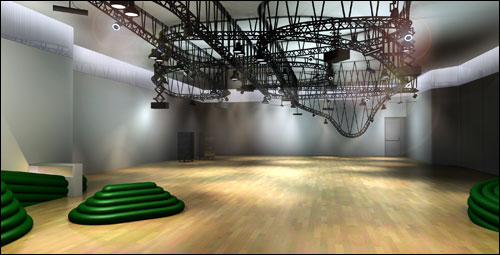As part of a French national project to put Near Field Communication (NFC) technology into the hands of consumers, the Centre Pompidou, an art museum in Paris, is planning to pilot a mobile phone system known as Smart Muse, in order to attract young visitors to its planned Teen Gallery. The gallery is scheduled to open in October 2010, and until then, the museum’s management will determine how it can use the RFID-enabled mobile phones to best reach young people through the mediums they are used to—social networking, such as Facebook and MySpace.
The Smart Muse system consists of NFC software known as Wave-Me, NFC RFID hardware that will be added to cell phones, and NFC RFID tags from Inside Contactless. Connecthings is providing content-management software and consulting services for this project, while the mobile phones will be supplied by Sagem Wireless.

The system will be installed to coincide with the new Teen Gallery’s opening in fall 2010, says Mauricio Estrada-Muñoz, the project manager of Centre Pompidou’s youth program department. By utilizing Smart Muse, visitors can wave NFC-enabled mobile phones near posters and exhibits equipped with NFC tags, in order to gain information and share their views with the museum—and, if all goes as planned, with friends and contacts via the Internet.
The NFC portion of the Teen Gallery project will be funded, in part, with a grant from France’s Ministry of Economy, Industry and Employment, as part of the latter’s objective to deploy new services that use NFC technology encompassing dozens of pilots utilizing contactless technology—most within the city of Nice, where Christian Estrosi, the department’s minister in charge of industry, also serves as mayor.
“We will be the first institution with a gallery specific for teenagers,” Estrada-Muñoz says. With that in mind, the museum intends to draw young visitors between ages 12 and 18, who are typically the least represented age group at art museums. To introduce and engage teenagers in the arts, he says, the museum plans to offer exhibits and programs specific to that age group, incorporating technology tools with which teens would be familiar. That is where NFC technology plays a role, he notes, because it allows teens to use one of their most familiar tools—a mobile phone—to choose what they would like to learn more about, as well as watch videos, listen to interviews, or obtain details regarding particular artists and schedules for programs with artists at the museum.
Each Sagem phone the museum will provide will be equipped with an NFC RFID module and antenna provided by Inside Contactless. Passive 13.56 MHz RFID tags compliant with NFC standards will be attached to posters and exhibits in the Teen Gallery. When a user moves his or her phone close to a tag, the handset will read that tag’s unique ID number. Using Wave-Me software residing on the phone, as well as on the server (hosted by Connecthings), the phone will access the server to download content related to that poster or exhibit, and display it on the handset’s screen.
The phones could also be used to send messages directly to museum management about specific exhibits, artwork and artists, allowing for a dialog between the institution and its patrons. But most importantly, Estrada-Muñoz says, the NFC system would provide publicity for the museum when patrons offer their views of the work with other young people via social networks. To make this possible, a phone’s user would input information, such as his or her Facebook address. When he or she inputs a response to the art, that comment could thereby be pasted on the page, along with other media, such as videos of the artist. For example, if a user selects a specific artist as a “favorite,” he or she can have that selection pasted onto his or her Facebook page, with links to additional details about that artist.
To make all of this possible, Inside Contactless will provide software that connects multilingual data from the museum about every tagged display that links to each tag’s unique ID number, says Loic Hamon, marketing VP for the company’s NFC business line.
When teens enter the museum—no admission is charged for youths under age 18—they can pick up a Sagem handset using Inside Contactless software, which they can use in the museum free of charge, then return it upon leaving the building.
The first exhibit, Estrada-Muñoz says, will focus on street art, exploring how such art has influenced the art community as a whole.
“This project has been very challenging for us,” Estrada-Muñoz states. “We want to take teenagers seriously”—and, through that effort, “show teenagers they can take the arts seriously as well.”
Inside Contactless is also providing the same technology for Nice’s old town. The system, expected to become operational in early 2010, will function as a travel guide. Tourists will be able to borrow one of approximately 100 Sagem phones owned by the city, provided on loan at tourist counters or offices. Alternatively, tourists who already own NFC-enabled phones could utilize their existing handsets to access information. The city of Nice will install RFID tags with InsideContactless NFC chips to marked signposts or walls near a number of attractions, such as museums and galleries.
By using the system, visitors can access a walking tour, obtaining information about each site they visit based on the tags they wave the phones next to. When the phone detects a tag, a link is made and InsideContactless software running on a server will upload text describing that site to the phone. The text may also recommend that the individual next visit another specific location, providing directions to that site. At each location, there will be an option to leave a comment with the city, or to send one to Facebook. In addition, Hamon says, there will be advertising opportunities allowing the phones to display information about, for example, a local restaurant. Bus schedules may also be made available.
Other projects in Nice include Veolia Transport, the public transport operator for the Nice Côte-d’Azur urban area, which has received funding to develop BPass+, a method of storing a rechargeable transport ticketing pass on an NFC phone. Gemalto will provide its MoBEMo contactless badge systems for business employees to use for access control, and to make cafeteria payments with an NFC phone. Cassis International is developing NFC SCM, a system allowing NFC phone holders to access tickets and coupons via a Web-based server. A project known as Nice Future Campus will allow 300 students at Nice University to use NFC-enabled phones for a variety of services, including downloading and redeeming tickets for programs on campus. And jewelry retailer Cléor will pilot an intelligent window for inventory tracking at its store, using RFID.


